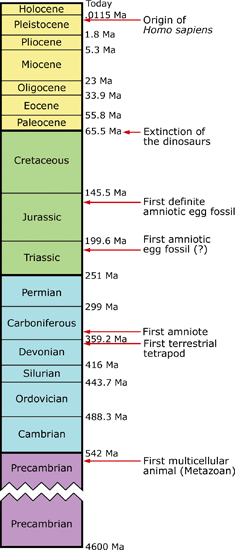 |
|
|
I. Introduction to eggshells |
Evolution of the amniote egg
 Figure 1. Generalized geologic time scale showing some of the definitive events in vertebrate, especially amniote, evolution. |
Amniotes include reptiles, birds, and mammals. It may seem surprising that mammals are amniotes — we don't typically think of them as egg-layers. However, early mammals laid eggs, and some modern mammals called monotremes (like the duck-billed platypus and echidna) still do. All other mammals (the placentals and marsupials) and some reptiles have lost the calcified shell and the female retains the egg during development, resulting in live birth. Most egg-laying amniotes produce eggshell calcium carbonate in the form of calcite (CaCO3); however, turtles, unlike all other amniotes, build their eggs out of aragonite (CaCO3 + magnesium). Organic material is deposited simultaneously with the calcium carbonate (Fig. 2). Pore canals run through the shell and permit gas exchange between the embryo and atmosphere.
The identity of the egg-laying animal can only be absolutely known if embryonic remains are preserved within an egg. Because shell unit structures are unique among taxa, they can be used to help in fossil eggshell identification and classification.
Physical properties of the amniote egg
Eggs can be divided into three general categories based on the physical properties
of the eggshell: soft, flexible, or rigid. Eggshell rigidity is determined by
the proportion of inorganic to
organic matter. Soft and flexible eggshell contains more organic matter than calcareous crystalline
material; conversely, rigid eggshell has more calcium carbonate (calcite or aragonite)
than organic matter incorporated into its structure.
Soft eggshell (Fig. 4): Most lizards, snakes, and tuataras lay soft eggs composed of an organic framework and poorly organized calcite crystals. These eggs collapse and shrivel after the animal hatches, and are therefore unlikely to be identified or even preserved in the fossil record.
Flexible eggshell (Fig. 5): Many amniotes, including some lizards, snakes, and turtles, lay eggs with flexible shells. These shells differ from soft shells because of their higher mineral content. Nevertheless, preservation of flexible eggs is also rare in the fossil record.
Rigid eggshell (Fig. 6): Some turtles and geckos, and all crocodilians, dinosaurs, and birds lay eggs with rigid eggshell. The calcite crystals form a relatively thick eggshell of interlocking shell units. Fossilization is more likely to occur in rigid eggshell because the crystalline calcium carbonate (calcite or aragonite) layer is stronger, more durable, and does not shrivel upon hatching.
Additional reading
Carpenter, K. 1999. Eggs, Nests, and Baby Dinosaurs: A Look at Dinosaur Reproduction. Indiana University Press. 338 pp.
Hirsch, K.F. 1994. The fossil record of vertebrate eggs. Pp. 269-294 in S.K. Donovan (ed.), The Palaeobiology of Trace Fossils. John Wiley and Sons.
Mikhailov, K.E. 1997. Fossil and recent eggshell in amniotic vertebrates: Fine structure, comparative morphology and classification. Special Papers in Palaeontology (56):1-80.
 |
|
 |
|
 |
|
 |
| Fossil eggshell home | Karl Hirsch and the Hirsch Eggshell Collection | Case studies | Interactive map |
Geologic time scale by Laura Wilson; Figures 2-6 courtesy of the University of Colorado Museum.